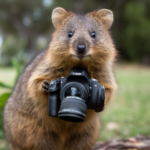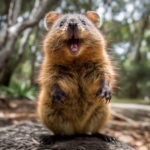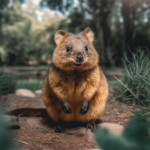The quokka, also known as the happiest animal on Earth, is a small marsupial native to Western Australia. Despite its small size, the quokka has gained worldwide fame for its adorable appearance and friendly demeanor. In this article, we will explore the size of quokkas, their physical characteristics, and how they compare to other animals. So, let’s dive in and discover more about these delightful creatures!
Key Takeaways
- Quokkas are small marsupials found in Western Australia.
- They are about the size of a domestic cat, with a body length of around 40-54 cm.
- Quokkas have a stocky build, short legs, and a round face with a short snout.
- Their small size and friendly demeanor have made them popular among tourists, earning them the nickname “the world’s happiest animal.”
- Quokkas are herbivores and primarily feed on grasses, leaves, and bark.
- Conservation efforts are in place to protect the quokka population and their habitat.
Understanding Quokkas: An Overview
A. Quokka: A Brief Description from Wikipedia
The quokka, also known as Setonix brachyurus, is a small marsupial native to Australia. These adorable creatures are often referred to as the “happiest animal on Earth” due to their seemingly constant smile. Quokkas belong to the macropod family, which includes kangaroos and wallabies.
Physical Characteristics
Quokkas are about the size of a domestic cat, with an average height of 40 to 54 centimeters (16 to 21 inches) and a weight of 2.5 to 5 kilograms (5.5 to 11 pounds). They have a round, compact body and short limbs. Their fur is coarse and usually brownish-gray, with lighter shades on their underparts. Quokkas have a short, broad head, rounded ears, and a small, black nose.
Habitat and Distribution
Quokkas are primarily found in Western Australia, particularly on Rottnest Island, where they are the most famous residents. They are also present on the mainland in scattered populations, mainly in the southwestern region. These marsupials inhabit a variety of habitats, including forests, shrublands, and coastal dunes.
B. Quokka in Canada: A Glimpse into Their Habitat
While quokkas are native to Australia, they are not found in Canada. These small marsupials are endemic to Western Australia and are not naturally found anywhere else in the world. Their habitat is limited to specific regions with suitable vegetation and climate.
Rottnest Island: Quokka Haven
Rottnest Island, located off the coast of Western Australia, is home to a large population of quokkas. The island’s unique ecosystem provides an ideal environment for these adorable creatures to thrive. With its diverse vegetation, including coastal dunes, woodlands, and heathlands, Rottnest Island offers an abundance of food sources for quokkas.
Conservation Efforts
Due to their limited distribution and vulnerability to habitat loss, quokkas are classified as a vulnerable species. The Australian government and various conservation organizations are actively working to protect their habitat and ensure their survival. Strict regulations are in place to control human interaction with quokkas on Rottnest Island, ensuring their safety and minimizing disturbance to their natural behavior.
In conclusion, quokkas are fascinating creatures with their unique physical characteristics and charming smiles. While they may not be found in Canada, their presence on Rottnest Island and in certain parts of Western Australia is a testament to the importance of conservation efforts. By understanding and appreciating these small marsupials, we can contribute to their preservation and ensure future generations can enjoy the sight of these happy little animals.
The Size and Appearance of Quokkas
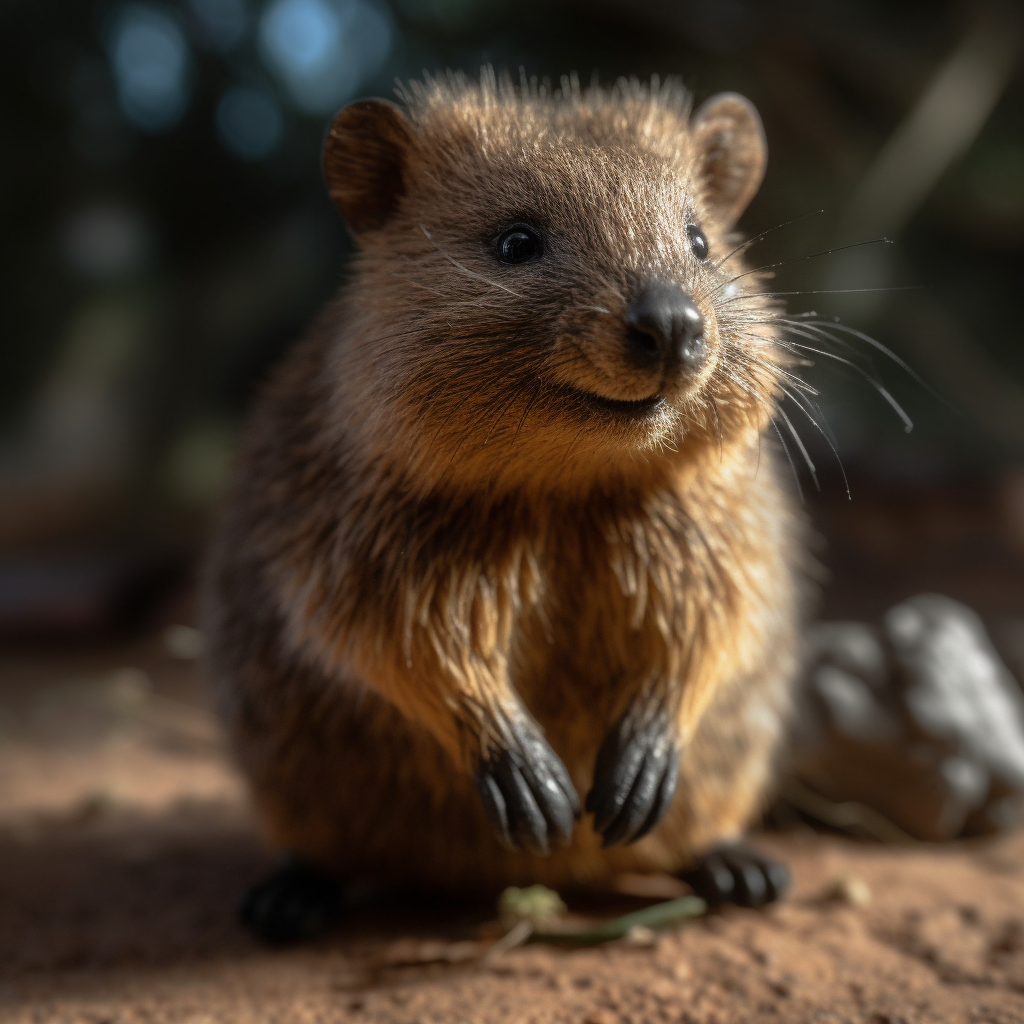
A. Quokka Size and Weight: A Comprehensive Analysis
Quokkas are small marsupials native to Australia, specifically found in Western Australia and on Rottnest Island. These adorable creatures are known for their friendly and curious nature, as well as their unique physical characteristics. Let’s take a closer look at the size and weight of quokkas.
When it comes to quokka size, adult individuals typically measure around 40 to 54 centimeters (16 to 21 inches) in length. They stand at an average height of 25 to 30 centimeters (10 to 12 inches) at the shoulder. In terms of weight, adult quokkas usually range from 2.5 to 5 kilograms (5.5 to 11 pounds).
To put their size into perspective, quokkas are roughly the size of a domestic cat or a small rabbit. However, their unique appearance sets them apart. Quokkas have a stocky build with a round face and a short, broad head. Their small, rounded ears and large, dark eyes give them an endearing expression. Their fur is coarse and usually a sandy brown color, which helps them blend in with their natural habitat.
B. Quokka Animal Size: How Big Do Quokkas Get?
Now that we have a general understanding of adult quokka size, let’s delve deeper into how big these animals can get. As mentioned earlier, adult quokkas typically measure between 40 to 54 centimeters (16 to 21 inches) in length. However, it’s important to note that individual quokkas may vary slightly in size.
When comparing quokka size to other animals, they are smaller than many common household pets. For instance, the average domestic cat is usually larger than a quokka, both in terms of length and weight. Similarly, small rabbit breeds can also surpass the size of a quokka. However, despite their smaller stature, quokkas have a unique charm that captivates the hearts of those who encounter them.
C. Baby Quokka Size: A Look at Their Early Growth
Baby quokkas, known as joeys, are born after a gestation period of approximately one month. At birth, they are incredibly tiny, measuring only about 2 centimeters (0.8 inches) in length. These miniature joeys are blind, hairless, and completely dependent on their mother for survival.
As they grow, baby quokkas spend their first few months inside their mother‘s pouch, where they continue to develop. Over time, they gradually start venturing out of the pouch and exploring their surroundings. By the time they are around six to seven months old, they become fully independent and leave their mother‘s care.
D. Quokka Litter Size: Understanding Reproduction
Quokkas have a unique reproductive cycle. After mating, the female quokka gives birth to a single joey, which she carries in her pouch. Unlike other marsupials, quokkas do not have a true pouch. Instead, the female‘s pouch is formed by a fold of skin on her abdomen.
The female quokka can breed throughout the year, but there is a peak in breeding activity during the warmer months. The joey stays in the pouch for about six months, during which time it grows and develops. Once the joey becomes independent, the female is ready to mate again.
In conclusion, quokkas are small marsupials with a unique size and appearance. Adult quokkas measure around 40 to 54 centimeters (16 to 21 inches) in length and weigh between 2.5 to 5 kilograms (5.5 to 11 pounds). They are smaller than domestic cats and rabbits but possess an undeniable charm. Baby quokkas are born tiny and grow inside their mother‘s pouch before becoming independent. Quokkas have a single joey at a time, and the female can breed throughout the year.
The Quokka Size Comparison: A Relative Perspective
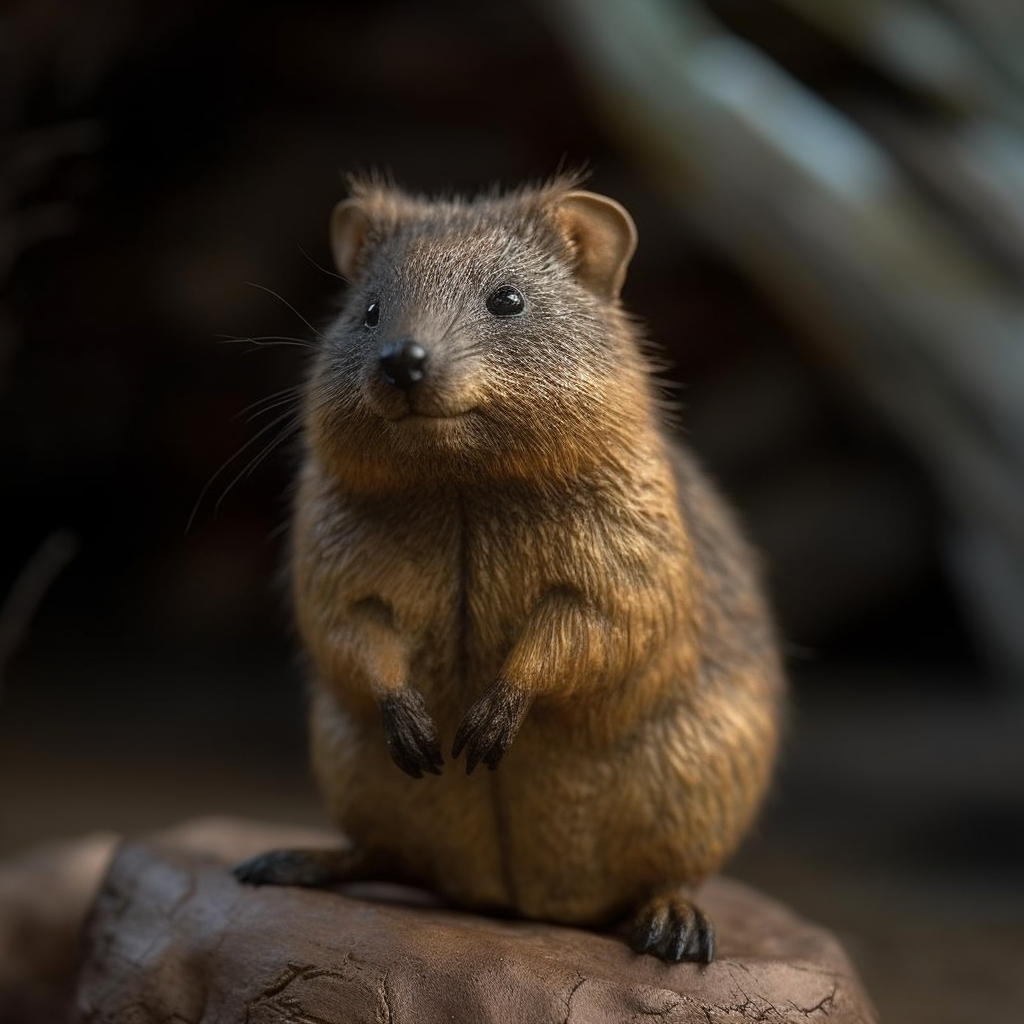
A. Size of Quokka: Comparisons with Common Animals
When it comes to the size of the quokka, this adorable marsupial from Australia is relatively small. While it may not be the tiniest creature in the animal kingdom, it certainly holds its own in terms of cuteness and charm. Let’s take a closer look at how the quokka measures up against some common animals.
1. Quokka Dimensions
The quokka measures approximately 40 to 54 centimeters (16 to 21 inches) in length, making it similar in size to a domestic cat. However, unlike cats, quokkas have a robust build with a round body and a short, thick tail. They weigh between 2.5 to 5 kilograms (5.5 to 11 pounds), which is roughly equivalent to the weight of a small rabbit.
2. Quokka Size Comparison to Human
In terms of height, quokkas stand at around 25 to 30 centimeters (10 to 12 inches) tall. This puts them at a similar height to a newborn baby. So, if you were to encounter a quokka in the wild, you would find yourself looking down at this pint-sized marsupial.
3. Quokka Size vs. Other Marsupials
Compared to other marsupials, such as kangaroos and wallabies, the quokka is relatively small. Kangaroos, for example, can grow to be over 2 meters (6.5 feet) tall and weigh up to 90 kilograms (200 pounds). Wallabies, on the other hand, range in size from around 30 to 180 centimeters (12 to 71 inches) in length, depending on the species. In comparison, the quokka’s size is much more compact and manageable.
B. Quokka Average Size: How it Stacks up Against Other Marsupials
Now that we have a general idea of the quokka’s size, let’s delve deeper into how it compares to other marsupials, specifically within its native Australian wildlife.
1. Quokka Size on Rottnest Island
The quokkas found on Rottnest Island, just off the coast of Western Australia, are known for their smaller size compared to their mainland counterparts. This is believed to be due to limited resources and competition for food. On Rottnest Island, adult quokkas typically weigh between 2.5 to 4 kilograms (5.5 to 8.8 pounds) and measure around 40 to 45 centimeters (16 to 18 inches) in length. These island-dwelling quokkas are often referred to as “Rottos” and have become a popular tourist attraction due to their friendly nature and photogenic smiles.
2. Quokka Size vs. Other Animals
When comparing the quokka’s size to other animals, it’s important to note that it falls on the smaller end of the spectrum. While it may not be as large as a kangaroo or as imposing as a wallaby, the quokka’s compact size is part of its charm. Its small stature allows it to navigate its natural habitat with ease, which consists of dense vegetation and shrubbery.
In conclusion, the quokka’s size may be relatively small compared to other animals, but it certainly doesn’t diminish its appeal. Its compact dimensions and adorable features make it a unique and beloved marsupial in the Australian wildlife. Whether you encounter a quokka on Rottnest Island or in its natural mainland habitat, you’re sure to be captivated by its pint-sized charm.
The Quokka’s Unique Characteristics
The quokka, a small marsupial native to Western Australia, is known for its unique characteristics that set it apart from other animals. From its perpetually smiling face to its size and survival tactics, the quokka is truly one-of-a-kind.
A. Why is the Quokka So Happy: The Science Behind the Smile
One of the most fascinating aspects of the quokka is its seemingly constant smile. This adorable expression has earned the quokka the title of “the world’s happiest animal.” But what exactly makes the quokka so happy?
Scientists believe that the quokka’s smile is not a reflection of its emotions but rather a result of its facial structure. The muscles around the quokka’s mouth naturally curve upwards, giving it a permanent grin. This unique feature has captured the hearts of people around the world and made the quokka a popular subject for selfies on Rottnest Island, where they are commonly found.
B. Why Do Quokkas Smile So Much: Unraveling the Mystery
While the quokka’s smile may not indicate its emotional state, it is true that these creatures are generally friendly and curious. They have a reputation for being approachable and unafraid of humans, which has only added to their popularity.
Quokkas are social animals that live in close-knit communities. They are herbivores, feeding on a variety of plants and grasses. Their diet consists mainly of leaves, stems, and bark, which they obtain by foraging during the night. This gentle and peaceful lifestyle contributes to their overall contentment and relaxed demeanor.
C. How Quokkas Escape Predators: Size and Survival Tactics
Despite their small size, quokkas have developed several survival tactics to escape predators. They are about the size of a domestic cat, with an average length of 40 to 54 centimeters (16 to 21 inches) and a weight of 2.5 to 5 kilograms (5.5 to 11 pounds). While they may seem vulnerable, quokkas have some clever strategies to protect themselves.
One of their primary defense mechanisms is their agility. Quokkas are excellent climbers and jumpers, allowing them to escape danger by quickly scaling trees or leaping away from predators. They also have strong hind legs, which enable them to hop away swiftly.
Additionally, quokkas possess a unique adaptation called “diapause.” This means that their embryos can pause their development until conditions are more favorable for their survival. This ability allows quokkas to delay the birth of their young during times of scarcity or when resources are limited.
In conclusion, the quokka’s unique characteristics, including its perpetual smile, friendly nature, and survival tactics, make it a fascinating creature to study and admire. Despite its small size, the quokka has managed to carve out a niche in the Australian wildlife and capture the hearts of people worldwide. So, the next time you come across a quokka, take a moment to appreciate its uniqueness and enjoy its contagious smile.
Quokka Ownership and Care

A. How to Own a Quokka: Legal and Ethical Considerations
Owning a quokka can be an exciting and rewarding experience. However, before considering bringing one into your home, it’s important to understand the legal and ethical considerations involved.
In Australia, quokkas are a protected species, and it is illegal to keep them as pets without the necessary permits. These permits are usually only granted for educational or conservation purposes. It is crucial to respect these regulations to ensure the well-being and conservation of these adorable creatures.
Even if you manage to obtain the required permits, it is essential to consider the ethical implications of owning a quokka. Quokkas are wild animals that are best suited to their natural habitat. They have specific dietary and environmental needs that may be challenging to replicate in a domestic setting. It is crucial to provide them with a suitable environment that allows for their natural behaviors and social interactions.
If you are passionate about quokkas and want to contribute to their conservation, there are other ways to get involved. You can support organizations that work towards protecting their natural habitat and promoting their welfare. By doing so, you can make a positive impact on the quokka population without compromising their well-being.
B. How Much Do Quokkas Cost: Financial Aspects of Ownership
While quokkas are undeniably adorable, the financial aspects of owning one should not be overlooked. The cost of acquiring and caring for a quokka can be quite significant.
As mentioned earlier, obtaining the necessary permits to own a quokka can be a complex and costly process. Additionally, the initial cost of purchasing a quokka can range from several thousand dollars to even higher amounts, depending on various factors such as availability and demand.
However, the expenses don’t end there. Quokkas require a specialized diet consisting of fresh fruits, vegetables, and high-quality pellets. These dietary needs can be expensive, especially considering that quokkas have a unique digestive system that requires specific nutrients.
Furthermore, providing a suitable habitat for a quokka can also be costly. They need ample space to roam and explore, along with appropriate shelter and enrichment items to keep them mentally stimulated. Regular veterinary check-ups and potential medical expenses should also be factored into the overall cost of ownership.
Considering all these financial aspects, it is crucial to carefully evaluate your budget and resources before deciding to own a quokka. It is essential to provide them with the best possible care and ensure their well-being throughout their lives.
C. Quokka Wheelchair Bag: A Unique Accessory for Pet Quokkas
If you are lucky enough to be in close proximity to quokkas, you might have the opportunity to interact with them on Rottnest Island in Western Australia. While it is not possible to own a quokka as a pet, there is a unique accessory that can enhance your experience of interacting with these adorable creatures – the Quokka Wheelchair Bag.
The Quokka Wheelchair Bag is a specially designed accessory that allows individuals with mobility challenges to carry a quokka in a safe and comfortable manner. It is a small bag that can be attached to a wheelchair or carried over the shoulder, providing a secure space for a quokka to rest while being transported.
This accessory is particularly useful for individuals who may have difficulty walking or standing for extended periods. It allows them to bring a quokka along on their adventures, ensuring they can still enjoy the unique experience of interacting with these friendly marsupials.
The Quokka Wheelchair Bag is designed with the quokka’s well-being in mind. It provides ample ventilation and space for the quokka to move around comfortably. The bag is made from durable and easy-to-clean materials, ensuring it can withstand the rigors of outdoor activities.
While the Quokka Wheelchair Bag is a convenient accessory, it is important to remember that quokkas are wild animals and should be treated with respect. It is crucial to follow guidelines and regulations set by the authorities to ensure the safety and well-being of both the quokkas and the individuals interacting with them.
In conclusion, owning a quokka as a pet is not a feasible option due to legal and ethical considerations. However, there are alternative ways to appreciate and interact with these adorable creatures, such as visiting them in their natural habitat or supporting organizations dedicated to their conservation. The Quokka Wheelchair Bag provides a unique opportunity for individuals with mobility challenges to have a close encounter with quokkas while ensuring their safety and well-being. Conclusion
In conclusion, the quokka is a small marsupial that is native to Western Australia. It is known for its adorable appearance and friendly demeanor, which has earned it the title of “the world’s happiest animal.” Despite its small size, the quokka plays a significant role in its ecosystem as a seed disperser and grazes on various plants. Its size, measuring around 40 to 54 centimeters in length and weighing between 2.5 to 5 kilograms, makes it the perfect size for its unique habitat on Rottnest Island and the mainland. The quokka’s small stature allows it to navigate through dense vegetation and find food efficiently. Additionally, its size makes it a favorite subject for tourists and photographers who visit the region. Overall, the quokka’s size is an essential aspect of its biology and contributes to its charm and appeal.
Frequently Asked Questions
1. What is the size comparison of a quokka to a cat or a rabbit?
Quokkas are small marsupials, typically measuring between 40 to 54 cm in length, which is slightly smaller than a domestic cat and larger than a typical rabbit. Their tail can add an additional 25 to 30 cm to their length.
2. Why do quokkas always seem so happy?
The ‘happy’ expression of a quokka is actually due to the shape of their mouth and the position of their teeth, which gives the appearance of a smile. This has earned them the title of the ‘happiest animal in the world’.
3. Where can I find more detailed information about quokkas?
For a comprehensive overview of quokkas, including their habitat, diet, and behavior, you can visit their Wikipedia page or the Quokka page on Wikikids.
4. What is the average weight and height of a quokka?
Quokkas typically weigh between 2.5 to 5 kg. Their height, from the ground to the top of their back, is usually around 12 inches or 30 cm.
5. How do quokkas escape from predators?
Quokkas are agile creatures and can climb small trees and shrubs to escape predators. They are also good swimmers, which helps them evade land-based threats.
6. How big is a baby quokka when it’s born?
A baby quokka, also known as a joey, is extremely small when it’s born, typically around the size of a jellybean. As it grows, it will stay in its mother’s pouch for about six months.
7. Why do quokkas always appear to be smiling?
The ‘smile‘ of a quokka is actually an anatomical feature. Their mouth is shaped in such a way that it appears they are smiling, which has contributed to their popularity.
8. Can I own a quokka as a pet?
No, it is illegal to own a quokka as a pet. They are protected by wildlife conservation laws in Australia, where they are native.
9. How big do quokkas get when they are fully grown?
A fully grown quokka can reach up to 54 cm in length, not including their tail. Their weight can range from 2.5 to 5 kg.
10. How much does a quokka cost?
Quokkas are not for sale as they are protected animals. It is illegal to own or sell them. They are a vital part of the ecosystem on Rottnest Island in Australia, where most of the population resides.

